RF & Microwave
Showing 17–32 of 160 results
-
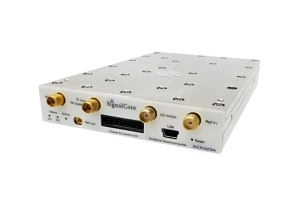
SignalCore SC5320A 40GHz Downconverter
The SignalCore SC5320A is a Ka band single stage Downconverter, with input RF range from 20 GHz to 40 GHz, external LO frequency range from 10 GHz to 20 GHz, output IF range from 100 MHz to 4 GHz, and 3 dB bandwidth of 2 GHz. This module features an internal synthesized local oscillator, selectable RF preamplifier, and variable gain control, making it a compact and versatile standalone downconverter module. With the option for an external LO, the SC5320A may be configured for SISO applications or paired together with multiple units for MIMO applications such as ground-based satellite communications, point-to-point radio, test instruments, and other RF measurement systems.
Features:
- Frequency Range: 20GHz to 40GHz
- Gain: -10 to +45 dB typ
- LO Phase Noise: < -110 dBc/Hz @ 10 kHz, 20 GHz
-
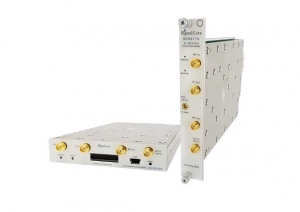
SignalCore SC5317A & SC5318A 26.5GHz Downconverter
The SignalCore SC5317A & SC5318A is a C to K broadband single-stage Downconverter, converting frequencies from 6 GHz to 26.5 GHz down to 50 MHz to 3 GHz. The LO frequency range is from 6 to 26.5 GHz with an input LO range from 6 to 14 GHz. An internal frequency doubler multiplies the input LO range up to 26.5 GHz. This module also features an internal 26.5 GHz synthesized LO, RF preamplifer, and variable gain control making it a compact standalone downconverter module. With the option for an external LO signal, the SC5317A & SC5318A may be configured for SISO applications or paired together for MIMO applications such as ground-based satellite communications, point-to-point radio, and test instrument systems.
The SC5318A can be combined with SignalCore’s SC5308A to form a broadband 100 kHz to 26.5 GHz Downconverter. These high-performance converter modules are compact, rugged, and built for simple integration into larger systems.
Features:
- PXI Express or USB-SPI-RS232 Platform
- Frequency Range: 6 GHz to 26.5 GHz
- Gain: -40 to +40 dB typ
- LO Phase Noise: -100 dBc/Hz @ 10 kHz, 10 GHz
-
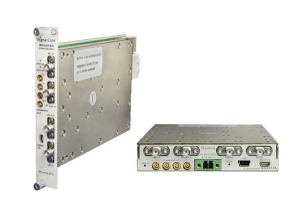
SignalCore SC5312A & SC5313A 6 GHz Direct IQ Demodulator
The SC5312A and SC5313A are 400 MHz to 6 GHz direct IQ demodulators, down converting RF directly to analog In-phase and Quadrature IF or IQ baseband. The DC coupled differential IQ pair may be fed to any dual channel digitizer for analog to digital data conversion. The local oscillator (LO) is supplied by an external source (such as the SC5505A and SC5506A respectively) and its replica may be used to drive another direct IQ downconverter for coherent reception. These modules can also be configured together as an RF signal transceiver.
Features:
- PXI Express or USB-SPI-RS232 Platform
- Frequency Range: 400MHz to 6GHz
- Analogue Baseline: DC to 160 MHz
- Noise Floor: < -165 dBm/Hz
-
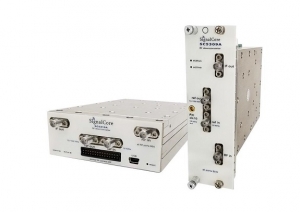
SignalCore SC5309A & SC5310A 2.5GHz Downconverter
The SignalCore SC5309A and SC5310A are 2.5 GHz Triple-Stage Downconverters. They are low cost integrated modules designed for radio and TV broadcasting, cable networks, and spectral monitoring applications. These modules feature high signal-to-noise dynamic range and high spurious free dynamic range. The phase noise is very low, at -105 dBc/Hz at 10 kHz offset with a typical noise floor of -153 dBm/Hz. The noise floor can be reduced to -170 dBm/Hz by enabling the internal preamplifer.
Features:
- PXI Express or USB-SPI-RS232 Platform
- Internal Preamplifier
- Frequency Range: 100 kHz to 2.5 GHz
- Bandwidth Options: 20 MHz or 40 MHz
- Tuning Resolution: 1Hz
- Phase Noise: < -105 at 10 kHz offset
-

SignalCore SC5307A & SC5308A 6.0GHz Downconverter
The SignalCore SC5307A and SC5308A are high performance, triple stage, Heterodyne Downconverters designed to meet demanding applications such as RF instrumentation, wireless communications, satellite link, software defined radio and signal intelligence. Both modules have input RF frequency ranging from DC to 6 GHz and selectable IF bandwidths of 80 MHz, 160 MHz, and 320 MHz. These wideband modules use a YIG oscillator as their tunable RF LO, which provide excellent phase noise, thus contributing negligible noise to the down-converted RF signal.
Features:
- PXI Express or USB-SPI-RS232 Platform
- Frequency Range: 100KHz to 6 GHz
- Tuning Resolution: 1Hz
- Bandwidth: Up to 320 MHz
- Phase Noise: < -100 dBc/Hz @ 10kHz, 1 GHz
-
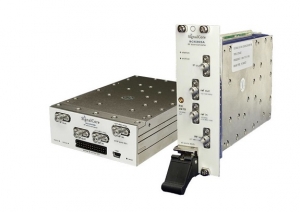
SignalCore SC5305A & SC5306A 3.9GHz Downconverter
The SignalCore SC5305A and SC5306B are three-stage superheterodyne RF Downconverters that deliver superior image rejection over single stage conversion. Designed to meet demanding applications such as cable modem testing, software defined radio development and spectral monitoring, these two modules have both high signal-to-noise dynamic range and high spurious free dynamic range. The excellent spurious free dynamic range is achieved using low noise linear amplifiers, low loss mixers, and high performance solid state attenuators.
Features:
- PXI Express or USB-SPI-RS232 Platform
- Frequency Range: 1 MHz to 3.9 GHz
- Measurement Sensitivity: -160 dBm/Hz
- Phase Noise: < -107 dBc/Hz @ 10 kHz, 1 GHz
-
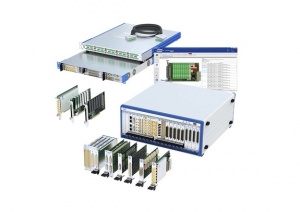
Pickering Switch Products
Enhance your engineering team’s effectiveness by working with our collaborative, creative and agile culture. Our over 50 years of experience in switching for automated test, along with a continually expanding range of PXI, PCI, LXI and USB switching and Simulation products, software and services—can help to streamline the development and deployment of your high-performance electronic test and verification systems
Features:
- PXI, PCI, LXI & USB Switch Systems
- Simulation Modules
- Programmable Resistor Modules
- RF & Microwave Switch Systems
- Optical Switch Systems
- Multiplexer and Matrix Systems
-
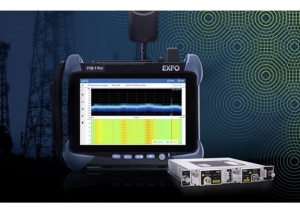
EXFO FTB 5GPro RF Spectrum Analyser
The EXFO 5GPro Spectrum Analyzer is a real-time Spectrum Analyzer (RTSA) that provides continuous acquisition of RF signals with
100 MHz of analysis bandwidth. Quick characterization of wireless signals and detection of intermittent interference is now possible
with the combination of the RTSA persistence and spectrogram view. EXFO brings innovation to RF testing with the new patent-pending Snap-to-Peak feature. By using the touch screen, field techs can identify interferers through a movable window which allows them to search for the highest amplitude interferer and attach a marker. A 5GNR Signal Analyzer supports the demodulation of 5GNR signals validating over-the-air (OTA) performance of cell sites and ensures smooth communication with user equipment. This application provides beamforming metrics and will analyze up to 64 beams and display the 12 strongest beams with the corresponding power measurements.Features:
- Frequency Ranges: FR1 (450 MHz – 6 GHz) or FR2 (24.25 GHz – 40 GHz)
- Physical Cell ID (PCI), Beam ID and SSB periodicity.
- Auto-detection of subcarrier spacing (SCS)
- Secondary synchronization – reference signal received power
- (SS-RSRP): linear average received power of each secondary synchronization signal (SSS) resource elements
- Secondary synchronization – reference signal received quality
- (SS-RSRQ): ratio of SSS power over the total power of a given number of resource blocks
- Secondary synchronization – signal to interference and noise ratio (SS-SINR): ratio of SSS over all noise sources, including interferers.
-
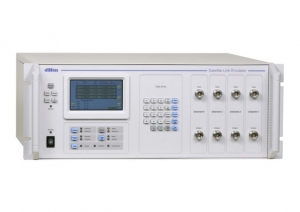
dBm Model SLE9000 Series Satellite Link Emulator
The dBm Model SLE900 replaces the SLE700 and provides wider bandwidth, improved noise floor, and also adds optional AWGN and multipath fading with up to 6 taps per channel. The instrument can be configured with 1 to 4 channels. There are three RF bandwidths currently available: 72 MHz bandwidth centered at either 70 MHz or 140 MHz, 125 MHz bandwidth centered at 140 MHz, and 250 MHz bandwidth centered at 1200 MHz. Link impairments include delay, Doppler, attenuation, phase offset, AWGN, and multipath. Parameters can be set to fixed values in Static mode, or continuously changed in real time in Dynamic mode without any phase discontinuities. Ephemeris data files are downloaded via an ethernet connection and stored internally in solid state memory. These dynamic files can have playback rates from 1 Hz to 1000 Hz, and can be run forward, reverse, continuously looped, or single stepped.
Remote control can be accomplished by making calls from your test software, or by using the SleControl application program provided with the instrument. This application provides control of all SLE functions, as well as manipulation of the dynamic data files.
- Centre Frequency : 70Mhz/140MHz, 140MHz & 1200MHz
- 1dB RF Bandwidth: 72MHz, 125MHz, 250MHz
- Independant Channels: 1, 2, 3 or 4
- Static and dynamic operation
- Phase continuous delay, Doppler, and attenuation changes
- AWGN and C/N generation
- 6 tap multipath fading with Rayleigh, Rician, AOA, k-factor, and correlation controls
- Ephemeris data generation using SATGEN
-
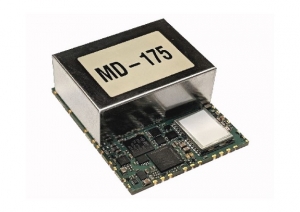
Microchip Vectron MD-175 GNSS High Stability Disciplined Oscillator
The MD-175 is a Microchip GNSS disciplined module. It is a fully integrated GNSS disciplined oscillator module in a compact surface mount 40x 50 mm footprint. The module has an embedded 72 channel receiver that is GPS, GLONASS and Galileo compatible and provides a sinewave or CMOS 10 MHz, and HCMOS 1pps output. An onboard precision OCXO provides stabilities in the unlocked mode enabling extremely low holdover. The module operates from -40 oC to +85 oC.
Key Features:
- CMOS or Sinewave Outputs (Model dependant)
- Holdover: 1.5 µs or 4us for 24 hrs w/2°C temp change (Model dependant)
- Temp Range: -40°C to 85°C
- Steady State Power: 2 Watts @ 25°C
- Phase Noise: -125 dBc/Hz at 10 Hz & -145 dBc/Hz at 1 kHz
- ADEV: 5.0 E-12 at 1 sec tau & 1.0 E-11 at 10 sec tau
-
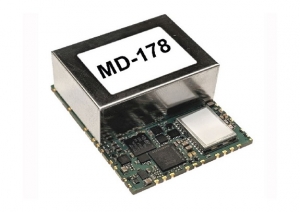
Microchip Vectron MD-178 GNSS Low Phase Noise Disciplined Oscillator
The MD-178 is a Microchip GNSS disciplined module. It is a fully integrated GNSS disciplined oscillator module in a compact surface mount 40 x 50 mm footprint. The module has an embedded 72 channel receiver that is GPS, GLONASS and Galileo compatible and provides a sinewave 10 MHz RF output, and HCMOS 1pps output. An onboard Low Noise OCXO provides a Low Phase Noise RF output. The module operates from -40°C to +85°C.
Key Features:
- Sinewave RF Output
- Temp Range: -40°C to 85°C
- Holdover: 10 µs for 24 hrs w/2°C temp change
- Steady State Power: 2 Watts @ 25°C
- Phase Noise: -135 dBc/Hz at 10 Hz & -165 dBc/Hz at 1 kHz
- ADEV: 5.0 E-12 at 1 sec tau & 1.0 E-11 at 10 sec tau
-
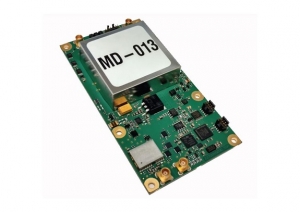
Microchip Vectron MD-013 GNSS High Stability Disciplined Oscillator
The Microchip Vectron MD-013 is a standard platform module that provides 1pps TTL, 10MHz sine wave and 10MHz square wave outputs that are disciplined to an embedded 72 channel GNSS Receiver. In addition, an external reference input can override the internal receiver as the reference. Internal to the module is a Microchip digitally corrected OCXO.
Key Features:
- Embedded GNSS Receiver – GPS, GLONASS, Galileo
- 1pps TTL output signal
- 10MHz sinewave and square wave output
- Adaptive aging correction during holdover
- Barometric pressure correction
-
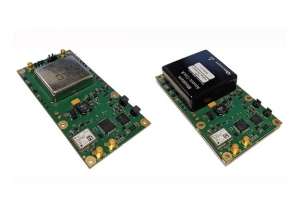
Microchip Vectron MD-015 GNSS Atomic Disciplined Oscillator
The Microchip Vectron MD-015 is a GNSS Disciplined Atomic Clock module. 1PPS TTL, 10MHz sine wave, and 10 MHz square wave outputs are generated from an on-board low-power SA.65s Chip Scale Atomic Clock, a high-stability SA53, or a high-stability SA55 Miniature Atomic Clock which is disciplined to an embedded 72 channel multi-constellation GNSS receiver or an external reference input supporting input frequencies from 1Hz (1PPS) to 120 MHz.
Key Features:
- Embedded GNSS Receiver – GPS, GLONASS, Galileo
- 1pps TTL output signal
- 10MHz sinewave and square wave output
- Adaptive aging correction during holdover
- Barometric pressure correction
-

Microchip Model 6300 Modular Signal Switching and Distribution System
The Microchip Model 6300 Series is a Hot-Swappable, Modular Signal Distribution System that supports High-Performance RF, Pulse and AM IRIG distribution. The 6300 Series delivers High Performance signaling for Metrology and RF applications without degradation. The 6300 Series is available in a 4U (6300-4) and a 1U (6300-1) chassis configuration. The 4U version can accommodate up to 12 Distribution modules while the 1U version can accommodate two Distribution modules. Most of the distribution modules come in two types of configurations. The switch module provides two inputs and four outputs. The two inputs provide a switching function that can be manually triggered or set up to automatically switch upon an input fault. The second type of module is a standard distribution module that provides one input and six outputs. In many configurations of the 6300 Series, a combination of both types of modules can be installed in the chassis.
Features:
- Low additive phase noise
- High channel isolation
- Modular design enables a variety of signal formats
- LED Status indicators for Inputs and Outputs
- Scalable to hundreds of outputs
- Ethernet interface for management and alarms
- Redundant AC or DC power or combination of AC and DC
- Hot-swappable modules and power supplies
-
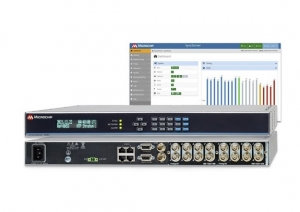
Microchip Model S650 GNSS Time & Frequency Standard
The SyncServer S650 Time and Frequency Standard provides unprecedented synchronization flexibility and performance using Microchip FlexPort™ technology. The GNSS-referenced S650 is easily adaptable for modern instrumentation systems and networks that require best-in-class synchronization performance for a wide range of applications.
This modular time server combines the best of time and frequency instrumentation with unique flexibility and powerful network-based and security-hardened features. The timing output flexibility provides easy replication of precise and coherent output signals, eliminating the need for a signal distribution chassis.
The Timing I/O module with eight BNC connectors is standard which includes the most popular timing I/O signals (IRIG B, 10 MHz, 1PPS and so on). When more flexibility is required, the unique Microchip FlexPort Technology option enables six of the BNCs to output any supported signal (time codes, sine waves, programmable rates), all configurable in real time via the secure web interface. The incredible BNC-by-BNC configurations makes very efficient and cost-effective use of the 1U space available.
- GNSS Stratum 1
- Frequency Accuracy: <1x10E-12
- Rubidium Atomic Clock or OCXO Options
- FlexPort: Selectable I/O
- IRIG B, 1MHz, 5MHz, 10MHz, 1PPS I/O
- Built-in DoS Detection and Protection
- Security-Hardened NTP Reflector™
- Secure Web-Based Management
- IPv6/IPv4 on all Ports
- Dual Power Supply Option
- PTP Option
- Fibre Optic Isolation I/O
- Havequick/PTTI
-
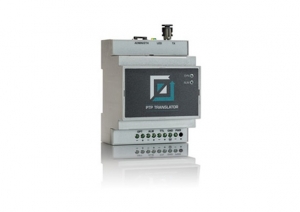
Microchip/Tekron Model PTP Translator
The Microchip/Tekron PTP Translator is a compact DIN-rail mount device that translates PTP (default, power and telecommunications profiles) to legacy time codes such as IRIG-B, DCF77 or user defined pulses. The PTP Translator enables you to migrate to PTP without having to incur the expense of replacing all your equipment that doesn’t support PTP.
- Input/Outputs: TTL, C37.118.1, RJ45 Ethernet/ST multi-mode Fiber Ethernet, ST Fiber
- Compact DIN-rail mounting form factor
- Allows IED’s equipped with IRIG-B, Pulse or other common Time Code inputs to conveniently access a PTP network
- Intuitive Configuration Software
- Enhanced Security and encryption that exceed NERC CIP requirements
